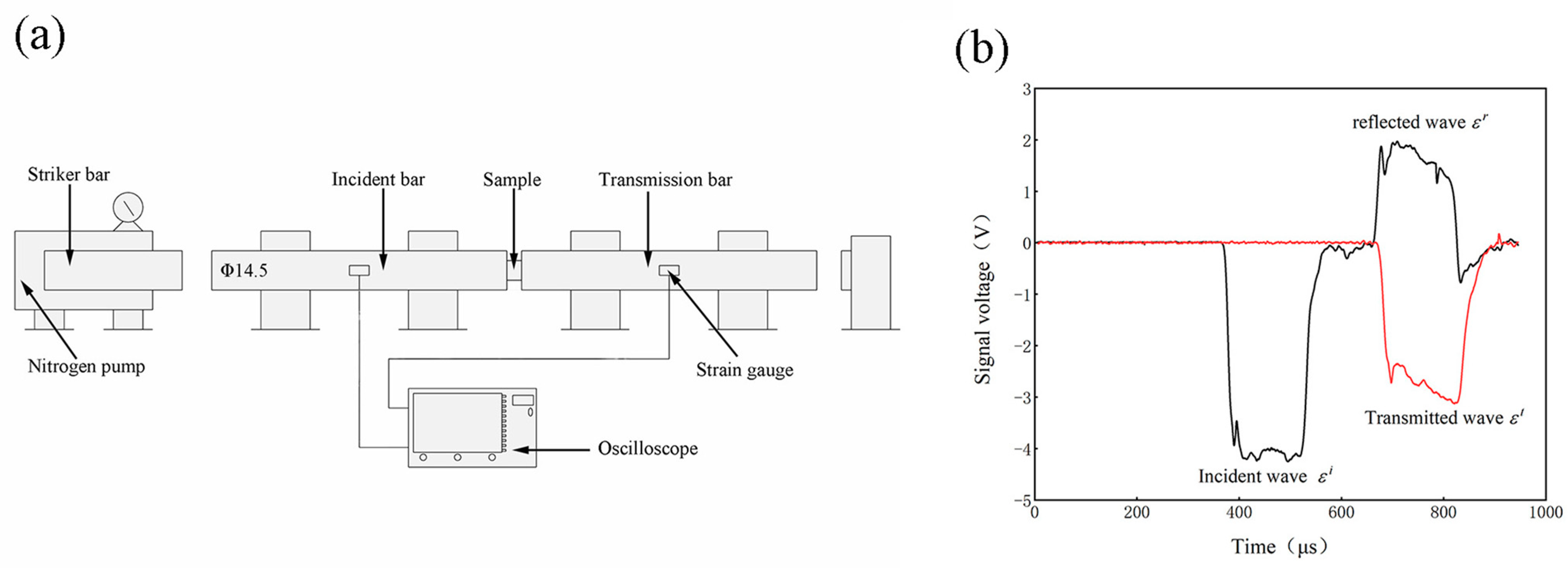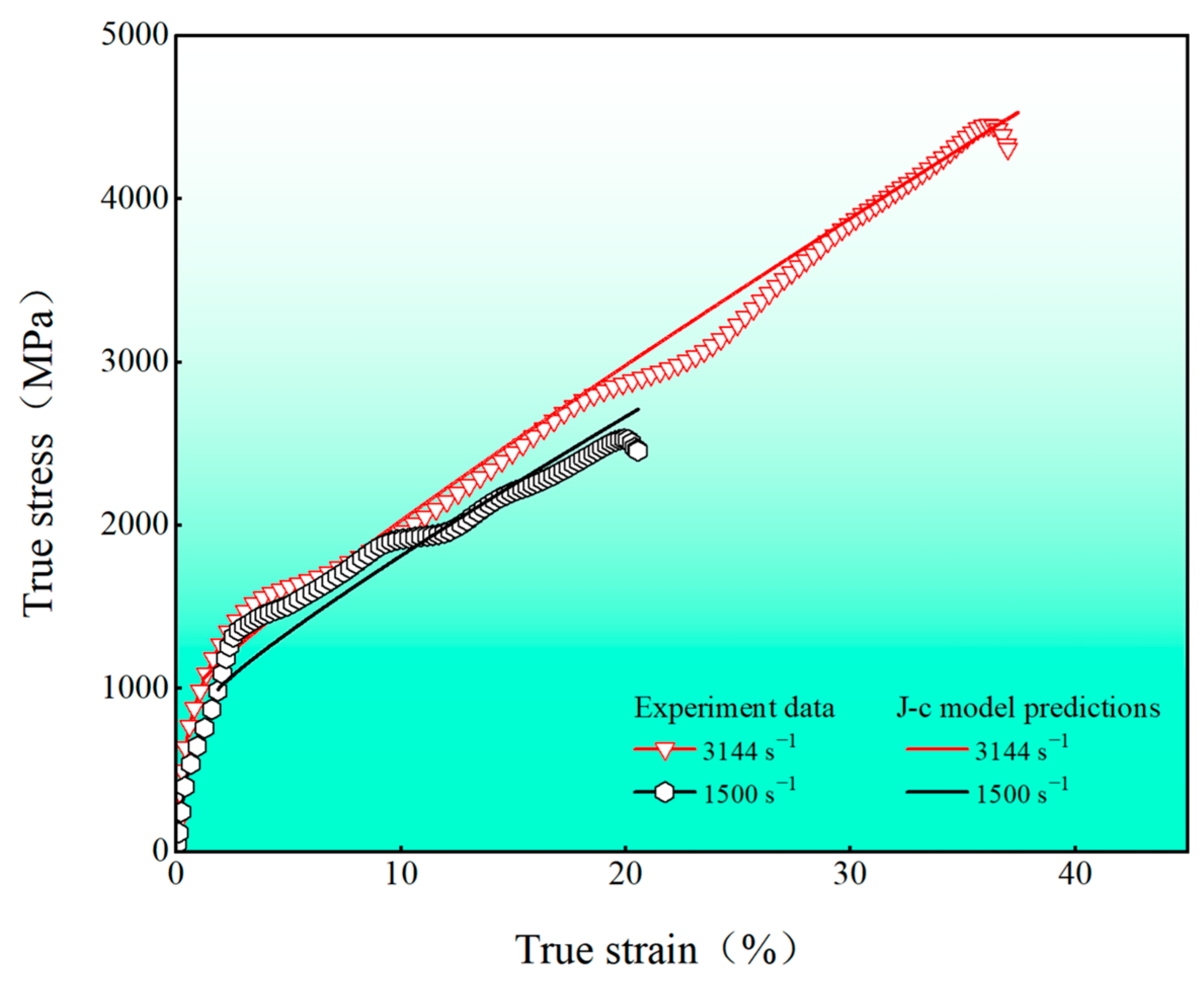Dynamic Compression and Constitutive Model in Fe-27Mn-10Al-1C Duplex Lightweight Steel
Abstract
:1. Introduction
2. Materials and Experimental Details
3. Results
3.1. Initial Microstructures
3.2. Mechanical Response
3.3. Microstructural Evolution upon Dynamic Compression
4. Discussion
4.1. Strain-Rate Sensitivity Effect
4.2. Strain-Hardening and -Softening Behavior
4.3. Constitutive Models upon Dynamic Compression
5. Conclusions
- (1)
- The present lightweight steel exhibits a significant strain rate effect. With the strain rate increasing from 10−3 s−1 to 3144 s−1, the corresponding yield strength increased from 735.8 to 1149.5 MPa. Their dynamic SRS (0.21) is significantly higher than previously reported FCC alloys, which is the main reason for good plasticity under high- strain-rate deformation.
- (2)
- Ferrite microstructure evolution is dominated by wave slip, which forms cellular structures, whereas planar slip dominates in austenite microstructure evolution, forming dislocation substructures such as high-density dislocation walls (HDDWs), microbands, and dislocation cells (CBs).
- (3)
- The present lightweight steels have achieved superior dynamic mechanical properties and extraordinary strain-hardening capacity, which can be attributed to the deformation twins (including secondary twins), dislocation substructures, and their extensive interactions.
- (4)
- The experimental results for dynamic compression are in perfect agreement with the predictions of the Johnson–Cook model, which suggests that the present dynamic-compression deformation process is determined by strain and strain rate.
Author Contributions
Funding
Data Availability Statement
Conflicts of Interest
References
- Zhang, W.; Xu, J. Advanced lightweight materials for Automobiles: A review. Mater. Des. 2022, 221, 110994. [Google Scholar] [CrossRef]
- Kim, H.; Suh, D.W.; Kim, N.J. Fe-Al-Mn-C lightweight structural alloys: A review on the microstructures and mechanical properties. Sci. Technol. Adv. Mater. 2013, 14, 014205. [Google Scholar] [CrossRef]
- Chen, S.P.; Rana, R.; Haldar, A.; Ray, R.K. Current state of Fe-Mn-Al-C low density steels. Prog. Mater. Sci. 2017, 89, 345–391. [Google Scholar] [CrossRef]
- Zambrano, O.A. A general perspective of Fe-Mn-Al-C steels. J. Mater. Sci. 2018, 53, 14003–14062. [Google Scholar] [CrossRef]
- Bai, S.B.; Chen, Y.A.; Liu, X.; Lu, H.H.; Bai, P.K.; Li, D.Z.; Huang, Z.Q.; Li, J.Y. Research status and development prospect of Fe-Mn-C-Al system low-density steels. J. Mater. Res. Technol. 2023, 25, 1537–1559. [Google Scholar] [CrossRef]
- Shih, M.; Miao, J.; Mills, M.; Ghazisaeidi, M. Stacking fault energy in concentrated alloys. Nat. Commun. 2021, 12, 3590. [Google Scholar] [CrossRef]
- Mahajan, S.; Chin, G.Y. Formation of deformation twins in f.c.c. crystals. Acta Metall. 1973, 21, 1353–1363. [Google Scholar] [CrossRef]
- Pierce, D.T.; Jiménez, J.A.; Bentley, J.; Raabe, D.; Wittig, J.E. The influence of stacking fault energy on the microstructural and strain hardening evolution of Fe-Mn-Al-Si steels during tensile deformation. Acta Mater. 2015, 100, 178–190. [Google Scholar] [CrossRef]
- Bai, S.B.; Li, D.Z.; Lu, H.H.; Niu, W.Q.; Liang, W.; Bai, P.K.; Huang, Z.Q. Enhancing strength and ductility combination via tailoring the dislocation density in medium Mn steel. Mater. Sci. Eng. A 2023, 879, 145227. [Google Scholar] [CrossRef]
- Chen, P.; Chen, R.; Li, X.W. Tensile deformation behavior related with strain-induced martensitic transformation in a duplex Fe-Mn-Al-C low-density steel. Mater. Charact. 2022, 189, 111954. [Google Scholar] [CrossRef]
- You, R.K.; Kao, P.W.; Gan, D. Mechanical properties of Fe-30Mn-10Al-1C-1Si alloy. Mater. Sci. Eng. A 1989, 117, 141–148. [Google Scholar] [CrossRef]
- Huang, H.; Gan, D.; Kao, P.W. Effect of alloying additions on the κ phase precipitation in austenitic Fe-Mn-Al-C alloys. Scr. Metall. Mater. 1994, 30, 499–504. [Google Scholar] [CrossRef]
- Haase, C.; Zehnder, C.; Ingendahl, T.; Bikar, A.; Tang, F.; Hallstedt, B.; Hu, W.P.; Bleck, W.; Molodov, D.A. On the deformation behavior of κ-carbide-free and κ-carbide-containing high-Mn light-weight steel. Acta Mater. 2017, 122, 332–343. [Google Scholar] [CrossRef]
- Frommeyer, G.; Brüx, U. Microstructures and mechanical properties of high-strength Fe-Mn-Al-C light-weight TRIPLEX steels. Steel Res. Int. 2006, 77, 627–633. [Google Scholar] [CrossRef]
- Li, M.C.; Chang, H.; Kao, P.W.; Gan, D. The effect of Mn and Al contents on the solvus of κ phase in austenitic Fe-Mn-Al-C alloys. Mater. Chem. Phys. 1999, 59, 96–99. [Google Scholar] [CrossRef]
- Hong, S.I.; Laird, C. Mechanisms of slip mode modification in F.C.C. solid solutions. Acta Metall. Mater. 1990, 38, 1581–1594. [Google Scholar] [CrossRef]
- Yoo, J.D.; Park, K.T. Microband-induced plasticity in a high Mn-Al-C light steel. Mater. Sci. Eng. A 2008, 496, 417–424. [Google Scholar] [CrossRef]
- Welsch, E.; Ponge, D.; Haghighat, S.M.H.; Sandlöbes, S.; Choi, P.; Herbig, M.; Zaefferer, S.; Raabe, D. Strain hardening by dynamic slip band refinement in a high-Mn lightweight steel. Acta Mater. 2016, 116, 188–199. [Google Scholar] [CrossRef]
- Yoo, J.D.; Hwang, S.W.; Park, K.T. Origin of Extended Tensile Ductility of a Fe-28Mn-10Al-1C Steel. Metall. Mater. Trans. A 2009, 40, 1520–1523. [Google Scholar] [CrossRef]
- Liu, C.Y.; Shen, S.C.; Xie, P.; Wu, C.L. Deformation behaviors of a Fe-20Mn-3Al-3Si TRIP steel under quasi-static compression and dynamic impact. Mater. Charact. 2022, 191, 112095. [Google Scholar] [CrossRef]
- Xiong, Z.P.; Ren, X.P.; Bao, W.P.; Li, S.X.; Qu, H.T. Dynamic mechanical properties of the Fe-30Mn-3Si-4Al TWIP steel after different heat treatments. Mater. Sci. Eng. A 2011, 530, 426–431. [Google Scholar] [CrossRef]
- Zhang, D.D.; Zhang, J.Y.; Kuang, J.; Liu, G.; Sin, J. Superior strength-ductility synergy and strain hardenability of Al/Ta co-doped NiCoCr twinned medium entropy alloy for cryogenic applications. Acta Mater. 2021, 220, 117288. [Google Scholar] [CrossRef]
- Gray, G.T. High-Strain-Rate Deformation: Mechanical Behavior and Deformation Substructures Induced. Annu. Rev. Mater. Res. 2012, 42, 285–303. [Google Scholar] [CrossRef]
- Wang, Y.Z.; Jiao, Z.M.; Bian, G.B.; Yang, H.J.; He, H.W.; Wang, Z.H.; Liaw, P.K.; Qiao, J.W. Dynamic tension and constitutive model in Fe40 Mn20 Cr20 Ni20 high-entropy alloys with a heterogeneous structure. Mater. Sci. Eng. A 2022, 839, 124837. [Google Scholar] [CrossRef]
- Foley, D.L.; Huang, S.H.; Anber, E.; Shanahan, L.; Shen, Y.; Lang, A.C.; Barr, C.M.; Spearot, D.; Lamberson, L.; Taheri, M.L. Simultaneous twinning and microband formation under dynamic compression in a high entropy alloy with a complex energetic landscape. Acta Mater. 2020, 200, 1–11. [Google Scholar] [CrossRef]
- Sun, J.; Zhao, W.X.; Yan, P.; Xia, X.Z.; Jiao, L.; Wang, X.B. Effect of temperature and strain rate on quasi-static and dynamic compressive behavior of forged CrMnFeCoNi high entropy alloy. Mater. Sci. Eng. A 2023, 870, 144846. [Google Scholar] [CrossRef]
- Liu, X.L.; Wu, Y.D.; Wang, Y.S.; Chen, J.B.; Bai, R.; Gao, L.; Xu, Z.; Wang, W.Y.; Tan, C.W.; Hui, X.D. Enhanced dynamic deformability and strengthening effect via twinning and microbanding in high density NiCoFeCrMoW high-entropy alloys. J. Mater. Sci. Technol. 2022, 127, 164–176. [Google Scholar] [CrossRef]
- Davies, E.D.H.; Hunter, S.C. The dynamic compression testing of solids by the method of the split Hopkinson pressure bar. J. Mech. Phys. Solids 1963, 11, 155–179. [Google Scholar] [CrossRef]
- Song, H.J.; Yoo, J.S.; Sohn, S.S.; Koo, M.; Lee, S. Achievement of high yield strength and strain hardening rate by forming fine ferrite and dislocation substructures in duplex lightweight steel. Mater. Sci. Eng. A 2017, 704, 287–291. [Google Scholar] [CrossRef]
- Wei, Y.; Li, Y.Q.; Zhu, L.C.; Liu, Y.; Lei, X.Q.; Wang, G.; Wu, Y.X.; Liu, J.B.; Wang, H.T.; Gao, H.J. Evading the strength–ductility trade-off dilemma in steel through gradient hierarchical nanotwins. Nat. Commun. 2014, 5, 3580. [Google Scholar] [CrossRef]
- Zhi, H.H.; Li, J.S.; Li, W.M.; Elkot, M.; Antonov, S.; Zhang, H.; Lai, M.J. Simultaneously enhancing strength-ductility synergy and strain hardenability via Si-alloying in medium-Al FeMnAlC lightweight steels. Acta Mater. 2023, 245, 118611. [Google Scholar] [CrossRef]
- Wang, Z.W.; Baker, I.; Cai, Z.H.; Chen, S.; Poplawsky, J.D.; Guo, W. The effect of interstitial carbon on the mechanical properties and dislocation substructure evolution in Fe40.4Ni11.3Mn34.8Al7.5Cr6 high entropy alloys. Acta Mater. 2016, 120, 228–239. [Google Scholar] [CrossRef]
- Dieter, G.E. Mechanical Metallurgy; McGraw-Hill: New York, NY, USA, 1976. [Google Scholar]
- Regazzoni, G.; Kocks, U.; Follansbee, P.S. Dislocation kinetics at high strain rates. Acta Metall. 1987, 35, 2865–2875. [Google Scholar] [CrossRef]
- Cao, T.Q.; Zhang, Q.; Wang, L.; Xiao, Y.; Yao, J.H.; Liu, H.Y.; Liang, Y.; Xue, Y.F.; Li, X.Y. Dynamic deformation behaviors and mechanisms of CoCrFeNi high-entropy alloys. Acta Mater. 2023, 260, 119343. [Google Scholar] [CrossRef]
- Yao, M.J.; Seol, J.-B.; Choi, P.; Herbig, M.; Marceau, R.K.W.; Hickel, T.; Neugebauer, J.; Raabe, D. Combined atom probe tomography and density functional theory investigation of the Al off-stoichiometry of κ-carbides in an austenitic Fe–Mn–Al–C low density steel. Acta Mater. 2016, 106, 229–238. [Google Scholar] [CrossRef]
- Ding, Q.Q.; Zhang, Y.; Chen, X.; Fu, X.Q.; Chen, D.K.; Chen, S.J.; Gu, L.; Wei, F.; Bei, H.B.; Gao, Y.F.; et al. Tuning element distribution, structure and properties by composition in high-entropy alloys. Nature 2019, 574, 223–227. [Google Scholar] [CrossRef] [PubMed]
- Sun, Q.Q.; Li, H.B.; Wang, S. Lattice rotation effect on the dislocation pattern of Cu deformed in tension. Philos. Mag. 2022, 102, 875–886. [Google Scholar] [CrossRef]
- Gutierrez-Urrutia, I.; Raab, D. Multistage strain hardening through dislocation substructure and twinning in a high strength and ductile weight-reduced Fe-Mn-Al-C. Acta Mater. 2012, 50, 5791–5802. [Google Scholar] [CrossRef]
- Wang, C.; Cai, W.; Sun, C.Y.; Li, X.T.; Qian, L.Y.; Jiang, J. Strain rate effects on mechanical behavior and microstructure evolution with the sequential strains of TWIP steel. Mater. Sci. Eng. A 2022, 17, 142673. [Google Scholar] [CrossRef]
- Khan, A.S.; Liu, H.W. Variable strain rate sensitivity in an aluminum alloy: Response and constitutive modeling. Int. J. Plast. 2012, 36, 1–14. [Google Scholar] [CrossRef]
- Duan, F.H.; Lin, Y.; Pan, J.; Zhao, L.; Guo, Q.; Zhang, D.; Li, Y. Ultrastrong nanotwinned pure nickel with extremely fine twin thickness. Sci. Adv. 2021, 7, eabg5113. [Google Scholar] [CrossRef] [PubMed]
- Chen, A.Y.; Zhu, L.L.; Sun, L.G. Scale law of complex deformation transitions of nanotwins in stainless steel. Nat. Commun. 2019, 10, 1403. [Google Scholar] [CrossRef] [PubMed]






Disclaimer/Publisher’s Note: The statements, opinions and data contained in all publications are solely those of the individual author(s) and contributor(s) and not of MDPI and/or the editor(s). MDPI and/or the editor(s) disclaim responsibility for any injury to people or property resulting from any ideas, methods, instructions or products referred to in the content. |
© 2024 by the authors. Licensee MDPI, Basel, Switzerland. This article is an open access article distributed under the terms and conditions of the Creative Commons Attribution (CC BY) license (https://creativecommons.org/licenses/by/4.0/).
Share and Cite
Cao, P.; Li, D.; Bai, S.; Chen, Y.; Lu, H. Dynamic Compression and Constitutive Model in Fe-27Mn-10Al-1C Duplex Lightweight Steel. Crystals 2024, 14, 178. https://doi.org/10.3390/cryst14020178
Cao P, Li D, Bai S, Chen Y, Lu H. Dynamic Compression and Constitutive Model in Fe-27Mn-10Al-1C Duplex Lightweight Steel. Crystals. 2024; 14(2):178. https://doi.org/10.3390/cryst14020178
Chicago/Turabian StyleCao, Pengfei, Dazhao Li, Shaobin Bai, Yongan Chen, and Haitao Lu. 2024. "Dynamic Compression and Constitutive Model in Fe-27Mn-10Al-1C Duplex Lightweight Steel" Crystals 14, no. 2: 178. https://doi.org/10.3390/cryst14020178



